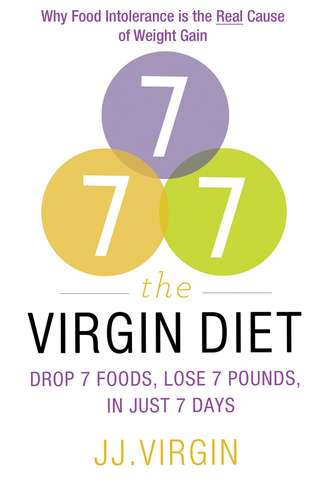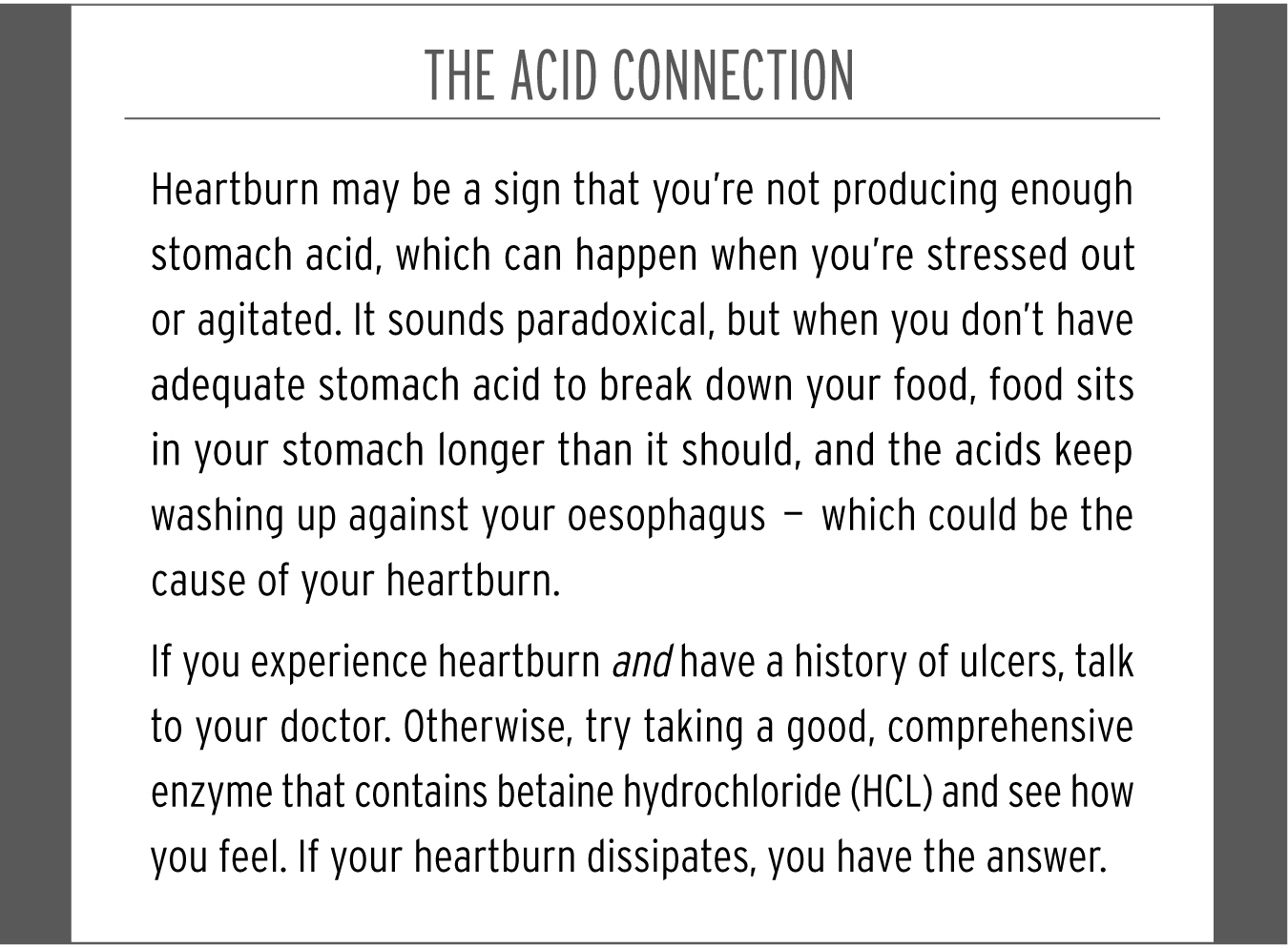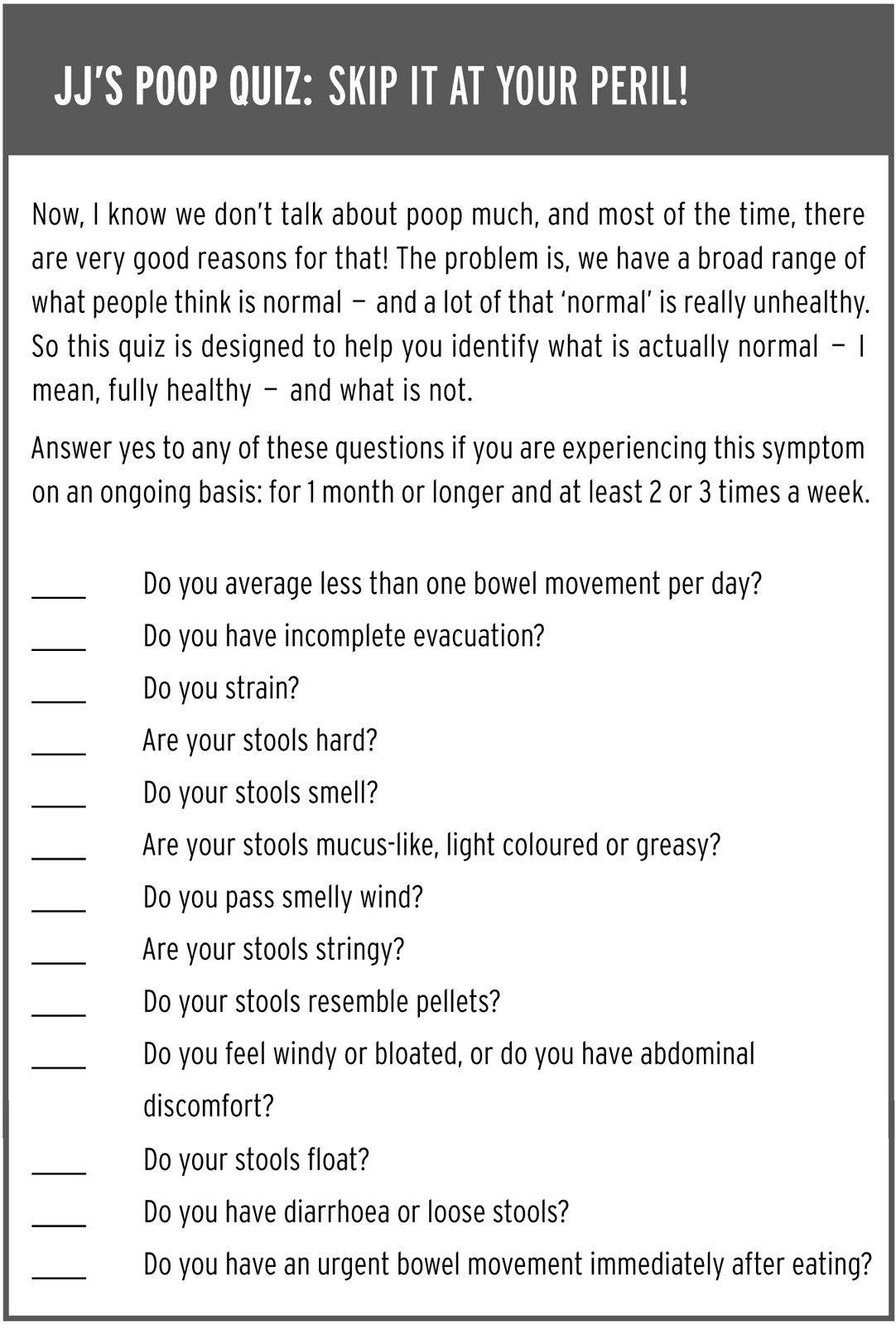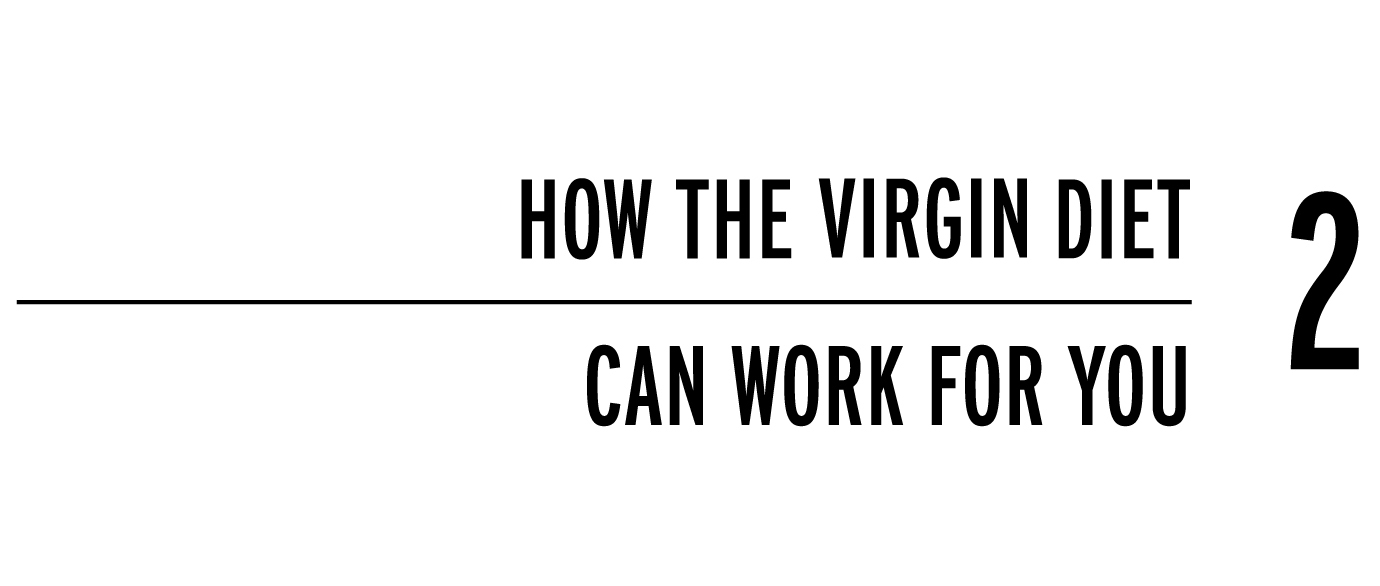
Полная версия
The Virgin Diet: The US Bestseller


Much of the reason for our poor digestion is how we eat. We eat too fast. I tell people, “Be a slowpoke when you’re eating.” Put your fork down in between bites. You can improve your digestion by increasing your chewing. Chew more. If we eat with people who eat fast, we tend to pace ourselves with them, so eat with slow people.
Mindful eating is not just taking the time to chew. It is also being calm while you’re eating. Take time for your meals. Focus on what you’re eating and the company around you – and don’t eat while you’re doing something else that needs your focus, such as driving or working. Keep your mind on the food and the pleasure of sharing it. You’ll enjoy it more – and you’ll eat less.


I don’t want to gross you out, but now we need to talk about poops because they are a crucial part of digestion. Either diarrhoea or constipation can indicate that you have problems digesting your food, which could ultimately affect your ability to lose weight.
Many people don’t realize that they are suffering from constipation. When I say, ‘constipation’, I want you to think three things:
1. You’re moving your bowels less than once a day. Ideally, you should be going twice a day.
2. You’re having to really struggle. Ideally, everything should come out nice and smooth.
3. You’re producing poops that are tiny or don’t easily come all the way out. That is not good for your digestive tract or your overall health.
What is a poop you can be proud of? It is a well-formed poop that you don’t have to struggle with. It comes out fully – it doesn’t stop halfway through and leave you stuck. Nor does it dive-bomb to the bottom of the bowl. It sinks to the bottom of the bowl. It doesn’t mark things up.
If you have an oily residue or slick slides, you are not absorbing your fat well. If you have rabbit pellets or you’re straining, you don’t have enough fibre. If you have floating poops, it could be from excessive wind, produced by an overgrowth of bad bacteria lurking in your intestines.
Now at this point, you might be wondering why I’m putting you through this kind of gross science lesson. The answer is, because if you don’t eliminate properly, you’ll be bloated and fat and setting yourself up for a permanent problem with both indigestion and obesity.
Okay, I’ll get a little more gross and ask you to picture what would happen to a poop that just sat in the toilet for a few days. Ewww, right? Well, do you want that toxic mess sitting inside you? No, you don’t, and that’s why elimination is so important. If you aren’t having poops you can be proud of, you are holding a toxic mess inside your body every single day. That uneliminated poop is releasing toxins that are reabsorbed into your body, leading to bad breath, piles and acne, not to mention impaired digestion, inflammation and food intolerance. The net result is that you gain weight that you can’t lose, and you feel sluggish, tired and old before your time.
Those toxins are also putting a terrific strain on one of your primary detoxification organs: your liver. If you tax your liver with excess toxins, you could impair its ability to do its other critical functions, such as metabolize fat, which will ultimately make it more difficult for you to lose weight.
Maybe this isn’t the most pleasant topic, but it’s an important one – and what we focus on, we can improve. So at this point, I’d like to invite you to take my poop quiz.

Okay, so here’s the deal: none of these symptoms are normal, and you shouldn’t experience any of them regularly on a long-term basis. You might have symptoms that occur periodically because of stress, a transient parasite, bad food – some problem that your body handles and you recover from. But if you have any of these problems chronically, you need to address them. And you should be aware that the more questions you answered yes to, the more severe your issue is.
Now, here’s the good news: quite often, removing high-FI foods and adding in healing and low-FI foods correct most if not all of the problems. Here’s some more good news: the Improving Your Poops section can tell you how to fix any remaining problems.

Now that you see how important pooping is for getting rid of toxins, let’s talk about things that can help you poop better.
First, make time for it. Everyone has a rhythm. You will find your best time of day. For most people, it is when they get up in the morning or about an hour after they wake up and move. Make sure you have time for that. You may also need to have another bowel movement in the afternoon after lunch. Start to get used to what your body needs so you can set time aside. You need the right place to be able to do this, too.
Second, you need to have one to three bowel movements a day. They shouldn’t be urgent, and you shouldn’t have to run to the bathroom every time you eat. When you eat, it should stimulate some peristalsis in 30–60 minutes. (Peristalsis is the contraction and relaxation of your intestinal muscles to move food through your digestive tract.) But you should not be feeling the urgent need to run to the bathroom as soon as you finish your meal. If you pull all of the top 7 high-FI foods from your diet and your urgency hasn’t cleared up in a couple weeks, see your doctor.

Fibre definitely gives us poops we can be proud of! You need fibre to add the bulk to your stools. Here are the top 10 sources of fabulous fibre, so load up on these:
1 Raspberries (All berries are high-fibre, and these are the highest.)
2 Lentils
3 Nuts
4 Seeds, especially chia seeds and freshly ground linseeds
5 Kale
6 Quinoa
7 Avocado
8 Apples
9 Winter squash
10 Broccoli
You need to eat optimal amounts of fibre. The average person is getting only 5 to 14 grams of fibre per day, but I want you to get it up to 50 or more. You can’t do it overnight. Add 5 grams each day until you reach your goal – and make sure to drink more water as you do so.

In Chapter 8, you’ll find my instructions for drinking water. Water and fibre together make a nice sponge that will give you the bulk you need in your stools.

Vitamin C: Start with 1 gram and increase as needed up to 5 grams each night.
Magnesium: Start with 300 milligrams and increase as needed up to 1,000 milligrams each night.
If your poops become runny, back off the supplements a bit. Iron and calcium are constipating, so if you are taking either of these, you may need some supplements to offset those effects. I like to take vitamin C and magnesium at night to get things moving in the morning.

Get things moving with exercise.
Try drinking some hot coffee or tea in the morning.
Sip some peppermint tea throughout the day.
Throw two or three prunes into your shake.
When you move your bowels, consider elevating your feet with a footstool – our toilets are just about the worst possible set-up for elimination.
If none of this is working, try cascara sagrada, senna, Chinese rhubarb and/or frangula (I prefer to use herbal blends of these) on a short-term basis. These are also great to take along if you happen to get constipated while travelling. You should only use them for a few days – don’t become dependent on them, as they may irritate the gastrointestinal lining long term with chronic use.

I know it’s hard to believe that the foods you’ve always thought were healthy are actually causing you to gain weight, feel lousy and look at least 10 years older. But trust me, I’ve had thousands of clients – from students to CEOs to top Hollywood stars – lose stubborn extra pounds, look 10 years younger and feel better than they had in years. The Virgin Diet is the key for me, for them and for you.

I’ve had thousands of clients lose extra pounds, look 10 years younger and feel better than they had in years.

If you’re feeling sceptical, leaf through this book, read some of my clients’ testimonials and see whether you recognize yourself in them. Most important of all, give the Virgin Diet a try. I’m only asking you for 21 days, and in return, I’m offering you a lifetime of feeling and looking your best.
Now, at this point, I’m going to give you a choice. If you’re totally on board with my reasoning and just want to get to the weight loss, jump right on over to Chapter 2 for a full explanation of what you’re going to be doing for the next 21 days and then turn to Part III to begin the Virgin Diet.
But if, like me, you don’t like simply following orders and prefer to understand how your body works, read on. In the next chapter, you’ll learn exactly how the Virgin Diet will help heal your body, and in Part II, you’ll find out just how the 7 high-FI foods are affecting your weight, your energy and your overall health. In other words, I’m going to give you the most useful chemistry lesson you’ve ever had in your life. This is the chemistry lesson that’s finally going to help you understand why you haven’t been able to lose weight before – and why you’re finally going to be able to lose it now.

Karen Bristing
Age 48
La Canada-
Flintridge, California
Height: 1.7m
Starting Weight: 11 stone 3 pounds
Waist: 79cm Hips: 104cm
Current Weight: 10 stone 2 pounds
Waist: 75cm Hips: 100cm
Lost: 1 stone 1 pound
I first heard about JJ Virgin through her book Six Weeks to Sleeveless and Sexy: The 5-Step Plan to Sleek, Strong, and Sculpted Arms. I started implementing her programme immediately – and seeing results – then I signed up for her online newsletter and heard about the concept of the Virgin Diet.
I had never tried eliminating gluten and dairy from my diet, never mind soy, corn, peanuts and eggs. I had been trying to lose a stubborn 5 pounds for years, but I was never able to do it on the traditional ‘eat less and exercise more’ programmes. And believe me, I tried them all! I had even tried extreme exercise, getting up at 5 AM for a gruelling hour of outdoor boot camp. I did that for years!
I also fell prey to ‘diet’ foods that were full of chemicals and artificial sweeteners. I was working out and I thought I was eating right. But the stress on my body kept me from ever getting below that number I hoped to see on the scale.
Now, I am working out less, eating according to JJ and loving it. I weigh less than I have in 10 years. Not only did I lose the elusive 5 pounds, but also another 10 fell off my body for a total of 1 stone and 1 pound down! My skin is clearer, too. I found that as soon as I tried to add dairy back into my diet, my skin broke out. So dairy has stayed out of my life.
The great thing is, I really don’t miss any of those foods. I have much more energy. My breakfast shake keeps me full until lunchtime. I no longer need to have some sugar after lunch to keep me going, and I don’t feel the need for an afternoon nap anymore. I fit into all the clothes in my closet, although buying more jeans in a smaller size has been fun.
I am just so glad that I found this programme. I’ve recommended it to my friends, and I enjoy seeing their successes as well. All I can say is that it has changed my life.


Jenna was a market analyst who routinely worked 12-hour days and rarely took a full day off. She was in her mid-30s, and she was as compulsive about her workout schedule as she was about her diet. She never took a bite she didn’t plan, and she insisted on eating healthy, organic and lean foods. In fact, I would have to say that despite her demanding schedule, Jenna put about as much energy into staying healthy and fit as anybody I’ve ever seen.
Yet, for the past few years, Jenna had been struggling with slow but steady weight gain that didn’t seem to respond to her efforts to step up her workouts or cut back on her occasional treats. By the time I started working with her, she was more than 2 stone 2 pounds over her ideal weight – and just about frantic with frustration.
That was nothing, though, to how she reacted when I told her she would have to cut the 7 high-FI foods out of her diet. She didn’t mind losing the sugar because she had pretty much cut it out anyway, and she was fine with giving up peanuts and corn, which she rarely ate. She could even wrap her mind around cutting out yeast and gluten because she was pretty much avoiding bread, pasta and baked goods already. But when she thought about cutting out her soy-laden protein bars, her low-fat Greek yoghurt, her freshly squeezed juice and her veggie omelettes, I thought she was going to go ballistic. And when I told her that fizzy diet drinks were off-limits, she was literally speechless for 2 minutes.
When she could finally speak, she said just four words: “JJ, are you sure?”
“I am.”
Then she started to bargain with me. “Maybe I could have, like, one protein bar during the day? I don’t think they have much soy – and I really need a high-protein snack I can eat at my desk. And maybe if I’m really good about the other things, I could have yoghurt, like, twice a week? Or maybe three times? Ever since I gained all this weight, yoghurt and berries are just about the only dessert I ever get – and the berries are healthy, right? And maybe as a special treat, I could have, say, one omelette at the weekend, if I don’t use any butter and fry it in a non-stick pan? One omelette – that’s only two eggs a week. I won’t even use the yolks, just the whites! That’s reasonable, right? I mean, moderation in all things, don’t you agree?”
“Look,” I told Jenna, “I know it’s tough to cut out so much, and after 21 days you might be able to add some of these foods, like eggs or dairy, back into your diet. But if you want this diet to work, it’s got to be 100 per cent compliance for the next 21 days. You have to cut out every single one of the top 7 high-FI foods. I’m not talking 99 per cent, I’m talking 100 per cent.”
“But why?” Jenna asked, almost in tears. For a minute, she sounded more like a distressed little girl than the high-powered financial wizard I knew she was.
I explained to Jenna that if she wasn’t struggling with food intolerance, she would certainly have been able to lose her excess weight by now. So I had to assume that she was plagued with leaky gut, inflammation and digestive difficulties and that even small amounts of high-FI foods would make them worse. Jenna’s gastrointestinal tract and her immune system were not functioning properly, and her stubborn weight gain was the result. To heal her body, we had to heal her leaky gut, cool her inflammation and give her immune system a chance to calm down. Even a single bite of egg or a spoonful of yoghurt might be enough to undo all of her efforts.
Jenna reluctantly agreed to follow the Virgin Diet, and for the first 3 or 4 days, it was tough going. Her immune system was used to making antibodies that would zap the dairy, eggs and soy in her system, and now those antibodies were causing her to crave those foods intensely. For those few days, even though she was doing everything right, Jenna actually felt worse.
“Hang in there,” I told her when she called me in despair. “This reaction is a good sign. You wouldn’t be having such a hard time giving up these foods if you weren’t sensitive to them. It’s like with an addict; you know how serious the addiction is based on how tough the withdrawal symptoms are. Your cravings are telling us that we are totally on the right track, so just give it a few more days.”
By the end of week 1, Jenna had started to feel better – especially when she realized that she had lost 7 pounds. By the end of week 2, she surprised herself with how clearheaded and focused she felt. By the end of week 3, she was thrilled to discover that she had lost a total of 10 pounds – and looked younger than she had in years.
Drop the top 7 high-FI foods for 21 days, lose up to 10 pounds or perhaps even more and look 10 years younger. It’s easier than it sounds. And the results are soooo worth it.


The Virgin Diet is a 3-cycle plan. In the first cycle, you cut out all of the top 7 high-FI foods. In the second cycle, you rechallenge your system each week with one of the four most reactive high-FI foods: soy, dairy, eggs or gluten. You might be able to tolerate some or all of these once your system has had a chance to heal, or you might have to let them go, at least for now. Finally, for the third cycle, I’ll show you how to experience these benefits for life. Maintaining your weight and losing weight require different strategies, and I’ll set you up to maintain your healthy diet while you also incorporate the exercise routine and lifestyle habits that are most effective for long-term success. You’ll learn how to periodically check in with your body for food intolerances and why it’s important for your health to eliminate the top 7 high-FI foods once a year.
Конец ознакомительного фрагмента.
Текст предоставлен ООО «ЛитРес».
Прочитайте эту книгу целиком, купив полную легальную версию на ЛитРес.
Безопасно оплатить книгу можно банковской картой Visa, MasterCard, Maestro, со счета мобильного телефона, с платежного терминала, в салоне МТС или Связной, через PayPal, WebMoney, Яндекс.Деньги, QIWI Кошелек, бонусными картами или другим удобным Вам способом.



